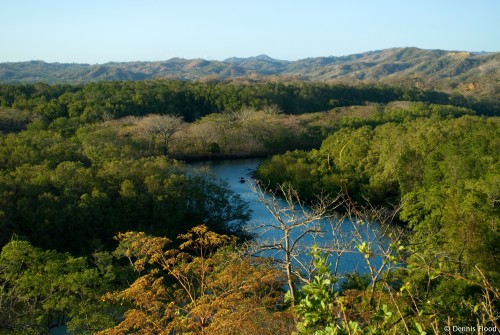In commemoration of Earth Day, and in light of one of the issues that touch us most profoundly in Nosara, NCA invited environmental advocate and lawyer María Fernanda Vargas González to share her thoughts about water resource management.
As an exceptionally dry season ends, you may have heard of Integrated Water Resource Management (Gestión integrada del Recurso Hídrico). What does that term mean in practice? And what implications does it have for Nosara?
Water is an integrating and unifying element, a basis for dialogue between people living upstream and downstream, whose use of water affects both natural and human environments. Watersheds encompass ecosystems both terrestrial (jungles, forests, shrublands, grasslands, and mangroves) and aquatic (rivers, lakes, and wetlands).
 Rio Nosara Valley
Rio Nosara Valley
Integrated water resource management promotes the coordinated development and management of water, soil, and related resources, with the goal of maximizing economic and social well being without compromising ecosystem sustainability. Water management involves various disciplines and subject areas — land use planning, forest management, soil, waste disposal, and public health, as well as issues of social and economic development.
Integrated water resource management is complex, involving biological, biophysical and technical elements. A dynamic rather than static or linear process, it focuses on long-term results. Although not perfect, it is continuous and interactive, and its practitioners realize that the pursuit of perfection can lead to stagnation.
Collaboration is essential, involving stakeholders drawn from all sectors of society: ASADAS, federal, regional, and local government, non-governmental organizations, and the private sector. The process must be done equitably, integrating vulnerable populations. Recognizing the fundamental role played by women in obtaining, using, and conserving water, and in acting as change agent, gender equity is of highest importance. When these elements are successfully combined, we achieve integrated, sustainable management in harmony with nature.
One example of integrated water resource management in Costa Rica is the Committee for the Integrated Management of the Río Purires Microwatershed (ComPurires). Located in the Valle Central, this microwatershed encompasses urban, periruban, and rural districts of El Guarco and Cartago, in the upper eastern part of the Río Reventazón-Parismina Basin. The watershed is increasingly vulnerable to threats typical of metropolitan areas brought about by changes in land use from expanding urban and agricultural frontiers and the growth of the industrial zone.
Río Purires communities began ComPurires in 2007. They used participatory management processes and involved local residents and institutions to research and promote actions that protect and recover water resources. The process began with biophysical and socioeconomic characterization of the zone, and then identified the key local agents (ASADAS, Asociaciones de Desarrollo, citizens involved in managing water resources, and private companies).
Their plan integrated environmental education, clean technologies, solid waste management, and improvements in water supply systems. Equally important, they instituted monthly meetings to make sure members communicated with each other and agreed on ways to maintain continuity and control in carrying out their activities.
ComPurires is an example of “good practices” in raising awareness about the use and sustainable management of water. It is the standard bearer of integrated water resource management as a means of achieving water conservation and recovery.
COMCURE (Committee for the integrated management of the Río Reventazón Watershed), in the Meseta Central, is another example of integrated management. These two groups can be models for Guanacaste communities working to preserve our local water resources. Happily, at least two such groups are at work.
Restoring our Watershed is active in the Nandamojo area, working with farmers to change the way they use their land, to harvest more rainwater and prevent erosion. http://ourwatershed.org/

El Corredor Biológico Río Nosara is a new group awaiting official recognition. Management of our large watershed, which extends from Monte Alto to the Pacific, will be divided into three groups. NCA is a part of the local Nosara section, which met for the first time yesterday, April 21, in Guiones. Watch for updates here as the group takes shape.
